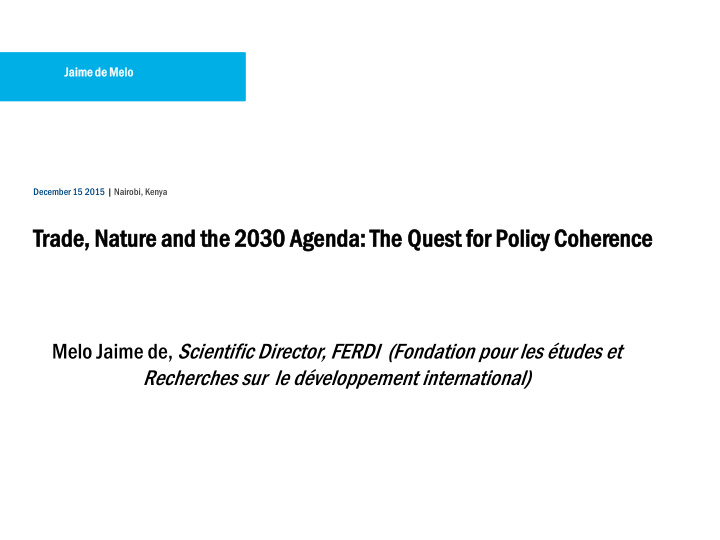



Jaime e de Melo December 15 2015 | Nairobi, Kenya Trade, , Natur ure and the 2030 Agenda: a: The Quest for Po Policy licy Cohere rence nce Melo Jaime de, Scientific Director, FERDI (Fondation pour les études et Recherches sur le développement international)
Trade in a Sustainable Development Strategy Three Trade-environment linkages (here) Where is WTS post-Paris in relation to SDG goals? 1. Art. 6 of Paris 2015 agreement has provision for «Internationally Transferred Mitigation outcome » so Cap and trade systems (CATs) are on board 2. MRV (monitoring, Verification, Verification) also accepted though difficult details left for later 3. Technology Mechanism not yet operational (smoothly operating WTS is needed to shift to carbon-free technologies via huge R&D effort (private & public to address our «Appollo» challenge). 4. Trade-related pressures on natural resources (depletion + GE resource curse effects). Need to improve governance of trade in natural resources (both on domestic and international fronts) Arguably on our way on 1. and 2. little progress on 4 essential for overall sustainability (art. 2 UNFCCC Rio 92 convention)
What Role for WTO in Global Architecture? • Overhaul architecture for Global Policy Making of current triad (IMF, World Bank, WTO) only for goods and financial flows must now reflect a world with stronger physical linkages. • Failure of environment-related Doha «mandate». (here). A bad augur for the SDGs ! • The subsidy problem (fossil fuels, water….and fisheries "Non- actionable»). Subsidy rules at the WTO need to be modified to distinguish «good» and «bad» subsidies. – «Bad» subsidies: First step: require MRV for subsidies. Could be done in WTO. Would be akin to current TPRM. – «Good» subsidies (for low-carbon R&D) and for adjustment to environmental objectives (like a carbon tax). Renew article 31 of SCM. Can these problems be dealt within WTO? Host to issue-based plurilaterals is essential for WTO to remain relevant in our quest to meet SDG goals
WTO: Go to issue-based plurilateral agreements • Contrary to GATT (with leeway), WTO (under SU straightjacket) is failing to deliver negotiated agreements. WTO should concentrate on its 2 other functions (monitoring gov’t decision-making and resolving disputes (DSU)) • … but WTO can also be host to issue-based plurilaterals like current EGA. Gets around obsession with focus on consensus and can multilateralize with «critical» mass. Variable geometry under bottom-up negotiations among «like-minded) more likely to give results. Many environmental directives under Maastricht have fared well. Alternative outcome will see progress on environmental issues and SDG-related goals in RTAs (e.g. subsidies, trade in endangered species in TPP).
Extra slides
A Taxonomy of Trade-Environment Linkages 1. Direct Trade-Environment Linkages – Trade-Related Pressures on sub-soil assets. Here domestic policy is trade policy in many cases. We need equivalent of MFN on export side (largely outside the GATT remit). An open process for allocating resource-extraction rights (e.g. along lines proposed by Extractive Industries Initiative is needed. – Transport-Related Emissions A club approach as in MARPOL (has worked) and an Artic black carbon treaty (might work)---network property gives a ‘ tipping point’ character and hence easier to get full participation. Tax on airplane travel (um offsets to transfer funds to developing countries) P attern of production . How to deal with notion of likeness for 2. [environmentally preferable products (EPPs), and with multiple use for Goods for environmental management, (GEMs)]?. A stalling point for the EGA negotations (here) ― Modify HS at WCO (to deal with ‘ likeness ’ complaints under Tariffs) and recognize ISO stds. (to deal with ‘ likeness ’ under TBT complaints) 3. By-product externalities of production – Local/regional (SO2, CO). Easier to deal with if no transjuridictional problem (e.g. short-lived local pollutants – CO, SO2) – Global (ambient) pollution: CO2, HFCs. Requires collective action and dealing with free-riding (an issue requiring more fundamental changes in WTO) (back)
Identifying/Classifying Goods Related to Preservation and Management of Environment (lawyers’ paradise, economists’ nightmare) Goods for Environmental Environmentally Preferable Products (EPPs): Management (GEMs) Single use (Pollution, Resources) Production Use Disposal Multiple end-uses -- Aluminium (Prebake -- Solar stoves --- packaging (glass vs. vs Soderberg) -- Solar furnaces plastic) -- Organic cotton vs -- Energy efficient --- Cotton fiber versus conventional cotton; consumer goods synthetic fiber Identification of use Identification Project Approach Relativism: to the frontier (static and dynamic) Finer/alternative HS-classification problematic Attribute Disclosure (requires an efficient disclosure mechanism (e.g. certification and harmonization) Processes and Production Methods (PPMs) and the like products at WTO Difficulties to negotiate on agricultural products (e.g. biofuels) and environmental services Lock-in if characteristics are embodied in HS code No coverage in the HS (products and services) for GEMs and EPPs (back)
Doha « no mandate » outcome on SDG objectives • Doha Art. 28. [mandate on fisheries] «..participants shall also aim to clarify and improve WTO disciplines on fisheries subsidies…» o No agreement on fisheries partly due to S&DT… Yet fish are «more visible» than climate. Perhaps relaxation of annex I non- Annex I at Paris can be extended here to help get agreement? • Doha art. 31 [mandate on EGs ]… same outcome: no agreement (and now stalling under the EGA — no agreement yet for Nairobi ministerial on the list or extent of tariff reduction: List of 54 to 411 and more goods have been discussed! ). o Very difficult to get agreement on classification of enviromental goods in part because of inherent technical difficulties in classification (here) ( back)
Recommend
More recommend